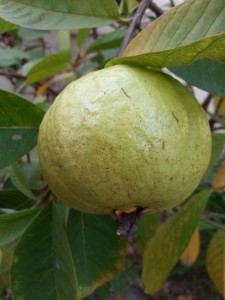Guava
Guava (Psidium Guajava) is a tropical fruit native to Mexico, Central America and the northern part of South America and is called guayaba, a Spanish word which the Filipinos used and became “bayabas” in the native dialect.
The tree can be grown from seeds, and will start fruiting within 2-4 years. It will produce fruits within its life span of 30-40 years depending on the variety. The trunk of the tree can be used as firewood and is being used today in Hawaii for smoking barbecue. The leaves are green and used in folk medicine to treat diarrhea. The fruits can be round or oval in shape and when you slice it open, the meat which is full of seeds also varies in color. Some are white and some are light or dark pink in color.
The fruit tastes sweet with a little bit of sourness. I like to eat guava when it’s ripe but not over ripe. It would be crunchy and juicy. The fruit is also filled with seeds that’s why birds like them too. The birds are responsible for the dispersal of the guava seeds in the forests. But most backyard trees are store bought and apple guava is the most popular variety chosen because of its thick fleshy skin and also bigger in size. We call it “Guava Java.”
Guavas have lots of uses and most are culinary. The ripe fruit is used in the Philippines to make “Fish Sinigang” a recipe which requires something sour to flavor the soup. We normally use tamarind for that. The juices are extracted for making beverages and cocktails, but it’s also popular in making jams and jellies. It also have healthful benefits because it contains Vitamins C and A and the phytochemical lycopene which is an anti-oxidant or anti-cancer.
